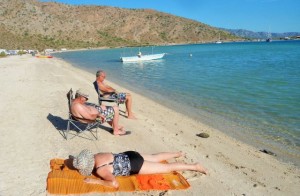
November 20, 2014 – Well it has been a few days since my last blog, a combination of busy and no access to internet. We promise Fun & Adventure and there has been plenty to go around. After leaving Guerrero Negro we headed south to San Ignacio, the section to Vizcaino is particularly narrow and we did a meet a Wide Load. I actually moved over into the path of the lead vehicle to get him to stop, then we all pulled off as far as we could and the load crawled by us safely, with possibly an inch (only 1) to spare. As we entered San Ignacio the Baja Mil was still on with a Pit Stop at Rice & Beans on the Hwy so we made a wide right off the highway, I just thought our PEMEX turnaround may be compromised with more race action (it was). When we took our tour into San Ignacio crowds of onlookers were still waiting for a few more stragglers finishing the race and sure enough a couple of cars did come thru. Later some enjoyed the Margaritas prepared by Ricardo and a few had dinner. When we departed in the morning the Baja Mil folks had all moved on to La Paz.

We had a great drive to Santa Rosalia, wow Odile sure messed things up, you can still see many vehicles that almost got washed out to sea still buried in debris. We pulled into Playa Santispac at noon and were set up in no time. Before you could say What colour, how many almost free the kayak and paddleboard were in the water and I had bought a hat from Pileo. Debbie & Dan had arrived from Vancouver Island the day before, George had been on the beach a few days longer. Rick & Marlene were also camped out we had not seen them for a while. Bruce & Marian were ready for our arrival and had collected vast amounts of firewood, we had a fire every night for our 3 night stay, thank you so much guys. Our time on Santispac was very relaxing and enjoyable the Pot Luck superb, what a selection we had. Took the gang to the beaches for a look around, Odile sure punished many of the Palapas.

Day 11 and we departed for Loreto which is one of my favourite drives, short, good road and very scenic, particularly that west view just after KM 68. No incidents on our drive all smooth sailing. A breif stop at the Military Checkpoint and we were on our way into town, the birthplace of the Californias. A couple of hours after we arrived we did a short look around town and a shop for a few groceries. The next day at 9 AM we headed for the excursion to the village and Mission of San Javier the 2nd oldest built in 1699. The road was better in some spots, worse in others, never seen this much water though, simply amazing. Later that evening we headed over to Marvin & Shelly’s house for our Baja Fiesta Dinner. They do such a great job and their neighbours Gary & Louise helped out as well, wonderful food, Shel demonstrated guacamole preparation, Louise made some killer desserts and Miguel & Martin serenaded us with some traditional Mexican tunes. This was fun for sure. We also bumped into Heather & Ken who have been travelling the world for 3 years and are now back to Baja. We saw them at Rivera Del Mar with Carl, another RVer we met on Juncalito many years ago. Hopefully they will catch up with their travel stories when we are in Puerto Escondido.

Today we we checked out the local Revolution Day Parade then lunch for those interested at Del Borracho, modeled after a Texas Saloon, always terrific hamburgers and fries. Tonight we dropping into the Giggling Dolphin for dinner, Ubaldo is always a gracious host and the grub good. Tomorrow morning we depart for Ciudad Constitucion, a shopping stop before Playa Tecolote and another 3 days on the beach.

Did you know?
Loreto (or Conchó) was the first Spanish settlement on the Baja California Peninsula. It served as the capital of Las Californias from 1697 to 1777, is often referred to as the birthplace of the Californias and is the current seat of the municipality of Loreto in the Mexican state of Baja California Sur. The city of 14,724 people (2010 census) is located on the coast of the Gulf of California, about 350 km (220 mi) north of the state capital, La Paz.

The town was founded in 1697 by Jesuit missionaries, who found a steady spring of fresh water on this site, as the Misión Nuestra Señora de Loreto. The Jesuits were expelled in 1767, and control of the Baja California missions was given to the Franciscans. In 1769, the Franciscans were ordered to turn over the Baja missions to the Dominican order and accompany the expedition of Gaspar de Portola to establish new missions in the unexplored northern frontier that became Alta California. The expedition departed from Loreto on March 24, 1769. As said earlier the town served as the capital of the province of Las Californias from its founding until the capital was moved to Monterey on February 3, 1777. In 1768, the province had been split into Alta California (today’s U.S. state of California) and Baja California. At first, the two provinces continued with a single governor. Later, the town became the headquarters for the Lieutenant Governor of California Viejo (the province of Baja California).

The city is now a tourist resort, catering mostly to Canadian & U.S. travelers, with daily flights from the U.S. state of California to Loreto International Airport. Many American tourists enjoy fishing in “pangas” for “dorado” (Mahi-mahi or Dolphin Fish). Local restaurants will willingly prepare the daily catch of the tourists. Loreto has a museum that coexists alongside the historic, but still active, parish. Loreto has active sister city relationships with Hermosa Beach and Cerritos, California, USA.

There are seven buildings in Loreto from the 18th to the 20th century that are considered historical monuments by the federal government; the most important is the Mission of our Lady of Loreto, which is at the start of El Camino Real (“The Royal Road”), an historic corridor that follows north along the ancient route of the Spanish missions, to its ending in Sonoma, California, USA. In the neighboring town of San Javier are five historical buildings, most importantly the Mission of Saint Francis Xavier (Misión de San Francisco Javier), the best preserved mission in the peninsula. The ruins of Mission of San Bruno, the first mission of Baja California, founded in 1683 by Jesuit missionary explorer Padre Eusebio Kino. It was ordered abandoned by the Spanish Crown a mere two years later. It is located twenty kilometers north of Loreto.

The Jesuit Missions Museum (“Museo de las Misiones Jesuíticas”) is located beside the Mission of our Lady of Loreto. It has a collection of religious art, weapons and tools from the 17th and 18th centuries that were used in the Spanish missions in Baja California. In the “La Giganta” Mountain Range (“Sierra de la Giganta”), there are cave paintings in canyons and rock shelters. The nearest sites to Loreto are “Cuevas Pintas” (15 km to the west) and “La Pingüica” (60 km to the North). The cave paintings from the indigenous groups of Baja California are world famous and some of them have been added to UNESCO’s list of world heritage sites.

According to INEGI, the 2005 city population was 10,283 people[10] with 2565 households, with 77.67% male and 22.32% female householders. The population is young: 29.75% are from 0 to 14 years of age, 19.19% from 15 to 24, and only 6.42% are 60 years of age or older. For every 100 females there are 102.5 males, and for every 100 females age 18 and over, there are 100.5 males. The Municipality of Loreto (which includes Nopoló, Puerto Escondido, San Javier and the rest of the little villages from the coast and mountains) has a population of 11,839 people. Due to Loreto’s small population and low immigration, large families are characteristic, and residents often have the same last name, a phenomenon also found in other state localities. The two largest families are the “Davis”, predominating in the east of the city, along the beach (“Calle Davis” is a street with this last name), and the “Murillo”, predominating in the south along the Arroyo Loreto, in the neighborhood known as “barrio del Muro”, named after the retaining wall built to hold flood waters from the creek. Other large families are the Amador, the Arce, the Cota, the Higuera, the Romero and the Villalejo.

From January to March, winds blow from the NW (night hours) and the North (day hours), the rest of the year, the winds blow usually from the West. Loreto’s yearly precipitation is low; averaging about 160 mm (6.3 in). The wettest months are August and September, when there are occasional short-lived rainfalls. One concern for Loreto is the Pacific hurricane season, which runs from August 1 to November 1, sometimes causes heavy rainfall and floods in the area, yes they have had some dandys. The last time the town area was hit by a hurricane was on September 15 2014, when the hurricane Odile hit the Baja California Peninsula making landfall at Cabo San Lucas.

Loreto has a reputation as an excellent sport fishing location. This is its main tourist attraction, as well as the main source of employment in the area, thus linking Loreto’s economy closely to fishing. There are two well-defined fishing seasons: summer features “dorado” and species like marlin (black marlin, Atlantic blue marlin, striped marlin) and sailfish, which are ideal for fly fishing; winter fishing features “yellow tail” (jurel) and other species that usually are deep in the sea rocks. In addition to these seasonal species, Loreto’s waters are home to other species like snapper and seabass, which are found all year long. Thanks to this abundance, Loreto has been home of several IGFA records. The two “foundations” of Loreto’s sport fishing are the “dorado” and the “yellow tail” (Seriola lalandi dorsalis). The dorado is the emblematic species of Loreto’s warm waters, its season beginning in late May, peaking from July to September, and ending in November, with two important tournaments, in July and September. The yellow tail is one of the strongest species; its season begins in November, peaks from March to April, and comes to an end in late May.

Diving-Loreto offers world class snorkelling and scuba diving, featuring warm water that makes wetsuits unnecessary most of the year, remarkable biodiversity, and good visibility. Golfing – The Loreto Golf Course is a par 72 course with 18 holes and two artificial lakes, located in Nopoló, 9 km south of the town. Tennis – The Loreto Tennis Center has 8 professional courts and a stadium, also located in Nopoló. Camping – Loreto offers from full service campsites, as well as deserted beaches. Kayaking – Several companies offer sea kayak tours. Sailing: Puerto Escondido, now renamed “Puerto Loreto” by the federal government, is south of Loreto. This port it is a safe natural harbor surrounded by hills, and is home to the “Sea of Cortez Project”, formerly known as Nautical Ladder Plan), operated by two government agencies. The Hidden Port Yacht Club is also based in this port, an internationally recognized club that is also involved in philanthropic activities.
Simply put Loreto has lots to offer everyone.



